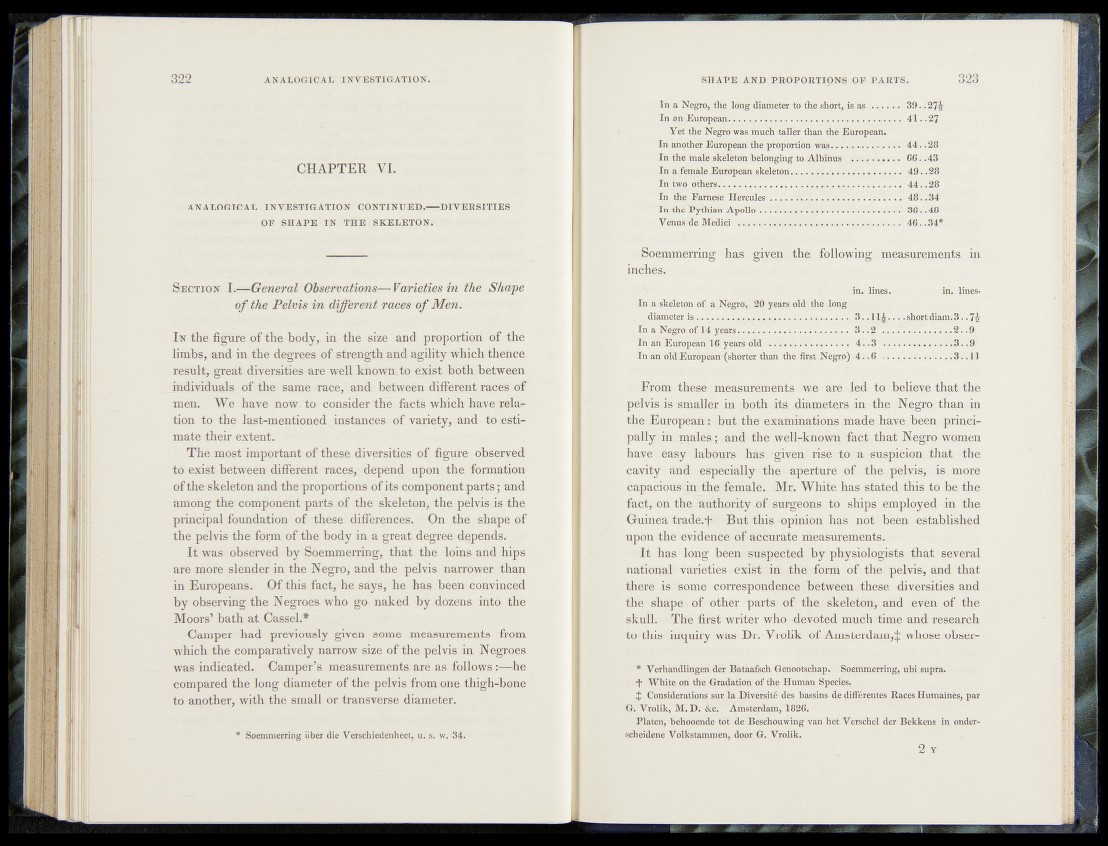
CHAPTER VI.
ANALOGICAL INVESTIGATION' CONTINUED,----DIVERSITIES
— OF SH APE IN THE y SKELETON»
S e c t io n I.—General Observations— Varieties in the Shape
o f the Pelvis in different races o f Mén.
In the figure .of the body, in the size and proportion of the
limbs, and in the degrees of strength and agility which thence
result, great diversities are well knowmto exist both between
individuals of the same race, and between different races .of
men. We have now to consider the facts which have relation
to the last-mentioned instances of variety, and to estimate
their extent;
The most important of these diversities of figure observed
to exist between different races, depend upon the_ formation
of the skeleton and the proportions of its component parts; and
among the component parts of the skeleton, the pelvis is thé
principal foundation of these differences. On the shape of
the pelvis the form of the body in a great degree depends.
I t was observed by Soemmerring, that the loins and hips
are more slender in the Negro, and the pelvis narrower than
in Europeans. Of this fact, he says, he -has been convinced
by observing the Negroes who go naked by dozens into the
Moors’ bath at Cassel.*
Camper had previously given some measurements from
which the comparatively narrow size of the pelvis in Negroes
wasindicated. Camper’s measurements are as follows:—he
compared the long diameter of the pelvis from one thigh-bone
to another, with the small or transverse diameter.
Soemmerring fiber die Verschiedenhect, u. s. w. 34.
In a Negro, the long diameter to the short, is a s ........... 39. .27&
In an European................ ...................................................41. .27
Yet the Negro was much taller than the European.
In another European the proportion-was........................... 44. .28
In the male skeleton belonging to Albinus , . . . . . . . . 66. .43
In a female European skeleton............................................4 9 .. 28
In two o t h e r s ........................................................... 4 4 .. 28
In the Famese Hercules . . . . ; < ................. ...........48. .34
Ih the Pythian Apollo .............. .................................. 36 . .48
Yenus de M e d ic i........... ..................... .. . V . ............... 46. .34*
- Soemmerring has given the -following measurements in
inches.
* ^ in. lines. in. lines.
In a skeleton of. a- Negro, 20 years old. thé long
idiameter }s. ...................................... 3. .1 1 ^ ... .shortdiam.3, -7è
In a l^egro of 14 years........ ................................. 3 . 7 ..' .*7.'.......... ..2 . .9
‘ In an Eufopean’lè years old . . . . . . . »............... 4.-;® I'. ................. 3. .9
In an old European-(shorter than the first Negro) ‘4 .. 6 . . . . . ; .............3 . . 11
From these1 measurements we are led to believe that the
pelvis is smaller rim both its diameters in the Negro than in
the European : but the examinations made ffave been principally
’in males;-and the welftknowU fact thafiNegro women
have fcfettBy. labours has given rise to a .-suspicion, that the
cavity i "and especially the aperture of the-pelvis, is more
capacious :in the female. Mr. White has stated this to be. the
fact, ©n the authority' ©ft surgeons to^ ships employed in the
Guinea trade, f - But this opinion has not been established
upon the evidence of-accurate -measurements.
I t has long been -suspected by physiologists that several
national varietiëS'iexist in the form of the pelvis,, and that
there is -some correspondence-daetWeen these diversities and
the shape - oft other parts of the skeleton, and even of the
skull. The first writer who devoted much time and research
to this inquiry was Dr. Vrohk of Amsterdam, J whose obser-
* Verhandlingen der Bataafsch Genootschap. Soemmerring, ubi supra.
•j* White on the Gradation of the Human Species.
$ Considerations sur la Diversité des bassins de différentes Races Humaines, par
G. Vrblik, M. D. &c. Amsterdam, 1826.
Platen, behooende tôt de Beschouwing van het Yerschel der Bekkens in onder-
scheidene Volkstammen, door G. Vrolik.
I 2 Y